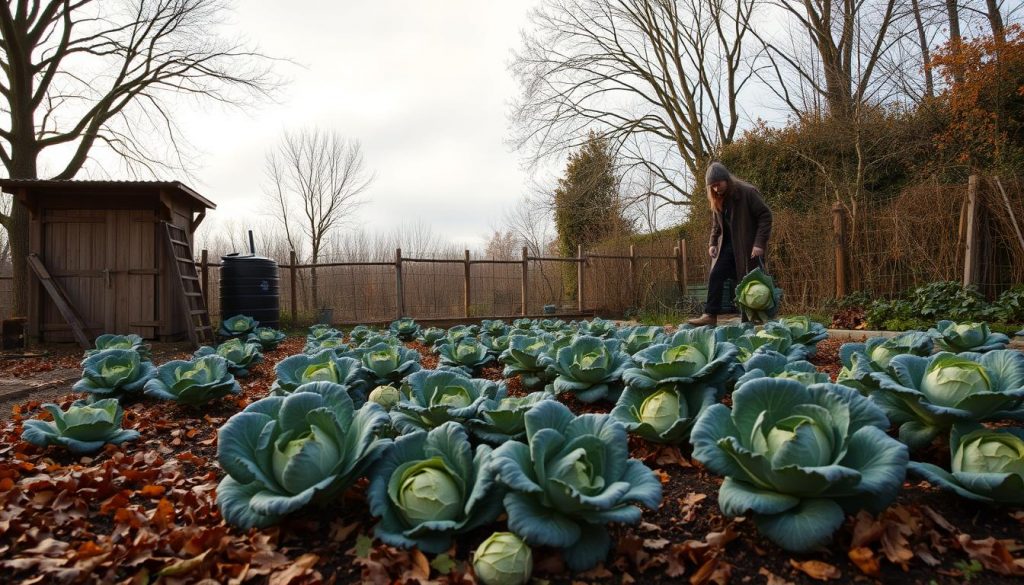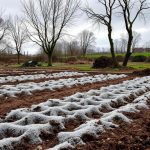Did you know that 30% of vegetable crops are lost each winter? This is often due to poor preparation and unexpected weather. As November arrives, it’s key to spend more time on the allotment. This ensures my garden can handle frosts and heavy rains.
This guide will cover the must-do tasks in November. We’ll look at soil preparation, planting, and protecting crops. By focusing on effective practices, I’ll prepare my garden for the cold months ahead.
Key Takeaways
- Early November is perfect for sowing grazing rye for winter nutrient retention.
- Adding an inch of sand or grit to garlic planting holes can prevent rotting in heavy soils.
- Monitoring winter brassicas is key because birds might eat them; use netting if needed.
- Pruning fruit trees like apples and pears in November boosts growth and health.
- November is the best time to plant bare-rooted canes for raspberries and blackberries.
- Reducing greenhouse ventilation on colder days is vital to avoid fungal issues.
Understanding the Seasonality of Allotment Work
November marks a big change in gardening, making it key for seasonal work in allotments. As it gets colder and darker, I need to change how I garden. Knowing these changes helps me plan better for planting and harvesting, and get ready for winter.
This month, I get to do things like plant tulip bulbs and sow hardy crops. It’s also the best time to plant bare root fruit trees and garlic sets for a good harvest later. Winter pansies, violas, and wallflowers add colour and grow well, making my garden look great.
With frost coming, I must think about how to protect my plants. Covering wallflowers with fleece helps them bloom in May. I also check my frost protection gear for young plants. By matching my gardening to nature’s cycles, my allotment stays strong, even in cold weather.
In November, I focus on keeping my garden in good shape. I clear beds and get ready for next year’s crops. It’s rewarding and vital for my allotment’s long-term health. Every task I do helps me prepare for the growing season.
Allotment Jobs in November
November brings us to the time when we focus on key tasks for the next gardening season. Preparing the soil is essential for both the current and future crops. With the right roles, my soil stays healthy and ready for spring.
Preparing Your Soil for Winter
This month, I make digging over my soil a top priority. I mix in organic matter like well-rotted manure. This improves the soil’s structure and adds nutrients.
It’s important not to compact the soil during this process. By adding these natural helpers, I get my garden ready for winter. I also keep an eye out for pests and decay, fixing any problems quickly to keep my garden thriving.
Importance of Soil Health
Healthy soil is full of life and supports a variety of plants. It’s the base for sustainable gardening and helps manage pests. I use boards and other supports to protect the soil from damage.
In November, I add manure and control weeds to help earthworms. This not only benefits my harvest next year but also follows the best practices for outdoor gardening.
| Task | Description | Benefits |
|---|---|---|
| Digging Soil | Incorporate organic matter like manure | Improves soil structure and nutrient levels |
| Weed Control | Remove old plant debris and weeds | Prevents pest harbouring and disease spread |
| Soil Support | Use boards to protect soil structure | Encourages healthy ecosystems |
Planting in November: What to Sow
November is a great time to start new planting jobs. Winter crops sowing begins, and I focus on crops that can handle the cold. Garlic, broad beans, and hardy winter peas are my top picks.
Garlic and Broad Beans
For garlic, I plant cloves 2.5cm deep. This helps them grow strong and prevents rot. Broad beans also go into my garden in November. They grow faster in milder areas, helping the soil stay healthy for future plants.
Hardy Winter Peas
Hardy winter peas are perfect for November. They can handle cold temperatures and make my garden productive. Early peas, for example, promise a spring harvest, letting me enjoy my work sooner. I also add flowers like Eryngiums to my garden. They need a cold start to grow well.
General Garden Tasks for November
As November comes, it’s key to do some general garden tasks. These tasks help get your garden ready for winter. Clearing and digging improve soil aeration and structure, which is vital for the cold season.
Clearing and Digging
Removing fallen leaves, dead plants, and debris is very helpful. It stops diseases and pests from spreading in the soil. Also, turning over the soil where veggies were grown helps with drainage and gets it ready for spring planting.
By balancing clearing and digging, you set a strong base for November’s allotment jobs.
Composting Techniques
Composting is essential in November. I make leafmould cages to break down leaves into compost. This method keeps moisture in and supports good garden life.
Adding kitchen scraps to the leaves speeds up composting. It makes the soil richer, helping my garden grow better. Good composting is key for a successful growing season.
Protecting Your Crops from Winter Pests
November brings damp weather, perfect for slugs and snails. I use organic slug pellets and traps to keep them away. These steps help protect my crops and follow allotment best practices.
Dealing with Slugs and Snails
I encourage beneficial wildlife like frogs and hedgehogs to fight pests. This natural approach reduces the need for chemicals. It makes my garden healthier and more resilient.
Using Netting for Brassicas
Netting keeps birds and pests off my brassicas. I make sure it’s tight to block any gaps. Regular checks help me catch any damage or pests early. This way, I ensure a good harvest despite winter’s challenges.
Harvesting: What’s Ready This Month?
November brings excitement as many crops are ready to be picked. It’s a busy time in the allotment, filled with opportunities to enjoy what we’ve grown. It’s important to know what to pick and how to store it for winter.
Root Vegetables and Greens
Root vegetables like carrots, parsnips, and leeks are perfect this month. I follow harvesting tips to pick them at the best time. This ensures they taste great and stay fresh. Kale also does well in the cooler weather, adding nutrition to our meals.
With the mornings getting cooler, now is the perfect time to enjoy these fresh foods from our allotment.
Storing Your Harvest
Storing our harvest properly is key to keeping it fresh longer. I use damp sand or peat for root vegetables. This keeps them moist but allows air to circulate. For greens, a cool, dark spot with damp kitchen paper is best.
This way, they stay crisp and fresh. Knowing how to store our crops makes the most of November allotment vacancies. It lets us enjoy our harvest even in the cold months.
Maintaining Your Greenhouse in November
November brings a change in focus for me. I now concentrate on keeping my greenhouse in top shape. Cleaning and disinfecting are key to stop fungal diseases. A good scrub and air flow are essential for a healthy space.
Insulating the greenhouse is vital. I use bubble wrap on windows to keep it warm. This not only saves energy but also creates a cozy spot for plants.
Keeping an eye on humidity is important. Regular checks help me avoid too much moisture. I make sure to open windows on mild days to keep air moving.
November is great for sowing broad beans and hardy peas in module trays. It gives them a good start before they go outside. I also watch over brassicas, covering them with netting to protect from wind.
Outside, I make sure taps and pipes are insulated to avoid frost damage. With a bit of extra effort, my greenhouse is ready for the winter and future growth.
Making the Most of Leafmould
November is a great time to collect leaves as trees lose their leaves. I gather leaves from my allotment and parks. Many councils offer free leaf collection.
To process the leaves, I make leafmould bins from chicken wire. This lets the leaves break down naturally over winter. It takes about a year for them to turn into nutrient-rich leafmould, thanks to fungi.
Collecting and Processing Leaves
Collecting leaves is easy. I make sure to mix different types of leaves. This mix makes the leafmould richer.
After collecting, I layer the leaves in my bins. I keep them moist to help them decompose. This method makes the leafmould better.
Benefits of Leafmould for Soil
Using leafmould in my garden has many benefits. It makes the soil better and holds more water, up to 50%. It’s a great natural fertiliser for my plants.
Using it as mulch protects my crops. It keeps them safe from cold and losing moisture. I use 5–10 cm of leafmould for this.
| Benefit | Description | Impact |
|---|---|---|
| Water Retention | Enhances moisture availability for plants | Up to 50% improvement |
| Soil Structure | Improves aeration and drainage | Leads to healthier root systems |
| Nutrient Availability | Provides essential nutrients as it breaks down | Supports plant growth and yield |
Pruning and Care for Fruit Trees
November is a great time for pruning fruit trees and soft fruits. This task shapes trees for the next growing season. It also helps with healthy growth and airflow. By doing this, my apple and pear trees will grow better, leading to more fruit.
Apple and Pear Pruning Techniques
When I look after my apple and pear trees, I remove dead or crossing branches. This helps them grow in an open shape. This shape lets more light in, which is key for fruit.
I cut back about one-third of last year’s growth. This makes the limbs stronger and the fruit healthier. These steps help increase the fruit yield.
Best Practices for Blackberries and Raspberries
Pruning soft fruits like blackberries and raspberries is different from tree pruning. Autumn-fruiting raspberries need cutting back to ground level in February. This helps them grow well.
Raspberries that bear fruit on last year’s canes need careful pruning. I remove older, weaker canes and keep the strong ones. This supports new fruiting shoots. For blackcurrants, I cut back one in three shoots to keep them productive and healthy.
I also mulch around the base of my berry canes to protect their roots. Doing these tasks in November prepares my garden for a good growing season. It ensures all seasonal garden tasks are done well.
Seasonal Allotment Maintenance Roles
This month, I focus on keeping my allotment in top shape. I look for pests or diseases to keep my plants healthy. Having a regular routine helps me manage my gardening tasks well.
Need for Regular Inspections
Regular checks are key in allotment maintenance roles. I spend time checking my plants’ health, making sure they get the right care as seasons change. This helps me spot any problems early and fix them before they get worse.
Community Efforts in Allotment Maintenance
Being part of community gardening brings us all closer together. We share tools and tips, making gardening more fun. Working together, we face challenges as a team, ensuring our plots flourish even in winter.
Preparing for the Next Gardening Season
As winter comes, I start getting ready for gardening. It’s a great time to organise tools and equipment. This way, I can start spring with everything ready.
Organising Tools and Equipment
I check my gardening tools, clean them, and fix any damage. Many gardeners forget to do this in winter, but it’s key. Keeping tools in good shape makes gardening more enjoyable and efficient.
Planning Your Next Crop Rotation
Preparing for the season also means planning crop rotation. This improves soil health and boosts garden productivity. By looking at past plants and soil needs, I plan for sustainable growth. Most gardeners see winter as a chance to start anew, making it perfect for planning.
| Task | Importance | Timing |
|---|---|---|
| Organise tools | Ensures readiness for spring | Before winter sets in |
| Assess soil needs | Promotes healthier crops | During crop rotation planning |
| Clean equipment | Prevents rust and damage | As part of winter maintenance |
| Plan crop rotation | Improves soil fertility | Prior to planting season |
| Mulch beds | Protects soil during winter | Throughout winter months |
By focusing on these tasks, I’m ready for the gardening season. With careful planning and upkeep, my allotment will flourish.
Outdoor Gardening Positions: Opportunities in November
November is a great time for those interested in horticultural employment opportunities. It offers many part-time allotment jobs. These jobs are perfect for those wanting to learn or make some extra money. Local gardens and allotments need help with seasonal tasks.
As the gardening season ends, employers look for people to help with upkeep. Tasks include harvesting crops like carrots and spinach. This experience improves your gardening skills and connects you with others.
Here’s a brief overview of key opportunities in outdoor gardening this November:
| Gardening Task | Potential Employers | Skills Developed |
|---|---|---|
| Harvesting Crops | Local Farms | Crop Identification, Harvest Techniques |
| Soil Preparation | Community Gardens | Soil Health Knowledge, Tool Usage |
| Planting Garlic and Spring Bulbs | Allotment Groups | Planting Techniques, Seasonal Planning |
| General Maintenance | Garden Clubs | Organisational Skills, Team Collaboration |
Working in these roles deepens my love for gardening. It also gives me valuable insights into the industry. You can learn from experienced gardeners and build a network. If you’re interested in gardening, now is the time to explore these opportunities.
Allotment Etiquette During Winter Work
As winter approaches, following allotment etiquette is key in our community. With fewer visits, respecting each other’s space is vital. Simple rules can make our allotment a better place for everyone.
Respecting plot boundaries is a must. I always try not to step on others’ land while working on mine. Saying hello when we pass each other adds to the community spirit.
Sharing tools and food helps build friendships. We often have extra produce, and sharing it is a kind gesture. I also keep some tools ready for others to use.
Keeping noise levels down is important. I use earphones to listen to music without disturbing others. This way, we can all enjoy the quiet of the allotment.
Winter brings its own set of challenges, but following these rules makes it better. Talking openly is essential, like when we can’t tend to our plots. A quick message to a neighbour keeps everyone in the loop.
Conclusion
Reflecting on my gardening in November, I feel proud of the work I’ve done. Tasks like preparing soil and planting garlic are key to a healthy garden in spring. The cold weather reminds me to stay active and engaged during winter.
Winter brings its own chances for gardening and building community. Plants like heather and snowdrops attract pollinators. Birds like robins and sparrows help control pests. It’s also a great time to learn about wildlife.
Wrapping up my gardening for the season prepares me for a bountiful spring. Cleaning the allotment and tools, and enjoying the fresh air, motivates me. I look forward to the vibrant life that spring will bring!
FAQ
What are the key allotment jobs I should focus on in November?
How can I prepare my soil for the upcoming winter?
Which crops can I plant in November?
What should I do about pests in my allotment during November?
How do I properly store my harvest during winter?
Is it important to maintain my greenhouse during November?
What is leafmould and how do I make it?
When should I prune my fruit trees?
How can I improve my allotment community experience?
Are there part-time allotment jobs available in November?

What Next?
Let me Guide you through the season “NEWSLETTER” Always know what to sow and when, your full guide to the growing season. (Monthly Newsletter) Simple easy to follow (No Fluff, Spam or filler) just good advice. https://veggiepatchideas.substack.com/
Helpful links
Search Deals on buying Plant Halos “Amazon” Click here
Take a look at my Amazon store front for guides and product reviews of the things that you need.
RHS: facts about grow your own Click here
Just starting your veggie patch? Start here with our beginners guide
Problems on the allotment? Remove Couch Grass or Remove Bindweed
Looking for an allotment in the UK? Try searching here first GOV.UK
The national allotment society Click Here
Other sites we love Gardeners world
*DISCLAIMER: Veggie Patch Ideas occasionally links to goods or services offered by vendors to help you find the best products to care for plants. Some of these may be affiliate links, meaning we earn a small commission if items are purchased. As an Amazon Associate, we earn from qualifying purchases.


